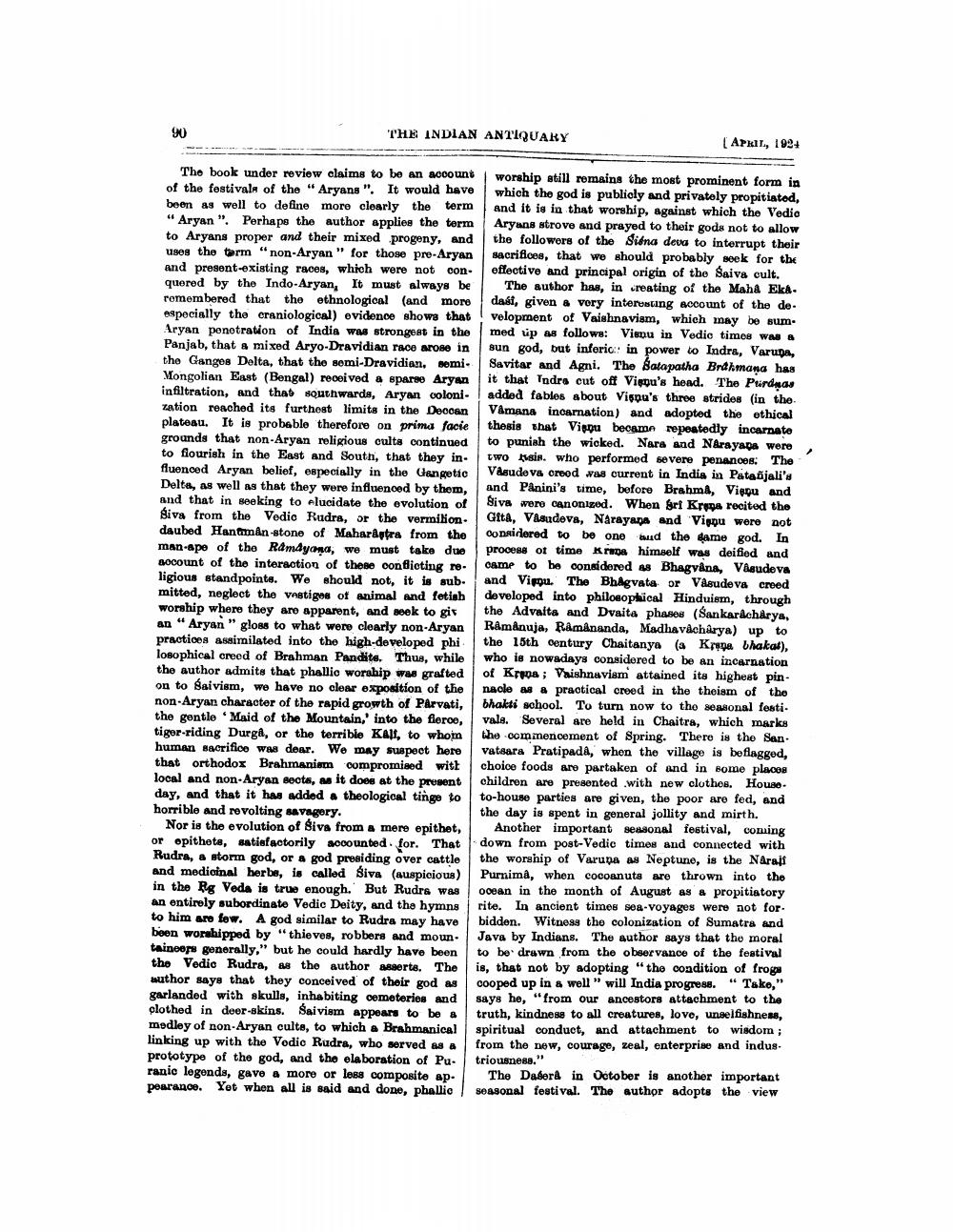________________
90
THE INDIAN ANTIQUARY
[ APRIL, 1994
The book under review claims to be an account worship still remains the most prominent form in of the festivals of the "Aryans ". It would have which the god is publicly and privately propitiatod, boon as well to define more clearly the term and it is in that worship, against which the Vedio "Aryan". Perhaps the author applies the term Aryans strove and prayed to their gods not to allow to Aryans proper and their mixed progeny, and the followers of the Siena deva to interrupt their uses the term "non-Aryan " for those pro-Aryan sacrifices, that we should probably seek for the and present-existing races, which were not con- effective and principal origin of the Saiva oult. quered by the Indo-Aryan, It must always be | The author has, in creating of the Maha Eka. remembered that the ethnological (and more dasi, given & very interesting account of the de. especially the craniological) evidence shows that velopment of Vaishnavism, which may be sumAryan penetration of India was strongest in the med up as follows: Vispu in Vedic times was a Panjab, that a mixed Aryo-Dravidian race arose in sun god, but inferio: in power to Indra, Varuna, the Ganges Delta, that the semi-Dravidian, nomi. Savitar and Agni. The Satapatha Brakmana has Mongolian East (Bengal) received a sparse Aryan it that Indrs cut off Vippu's head. The Purdgas infiltration, and that southwards, Aryan coloni! addod fables about Vispa's three strides (in the zation reached its furthest limits in the Deocan Vamana incarnation) and adopted the ethical plateau. It is probable therefore on prima facie thesis that Vippu became repeatedly incarnato grounds that non-Aryan religious culta continued to punish the wicked. Nara and NArayags were to flourish in the East and South, that they in two sis. who performed severe penances. The fluenced Aryan belief, especially in the langetic Vasudeva creod was current in India in Patañjali's Delta, as well as that they were influenced by them,
and Panini's time, before Brahma, Viegu and and that in seeking to lucidate the evolution of Siva were canonized. When Erf Kripa recited the Siva from the Vedio Rudra, or the vermilion.
Gita, Vasudeva, Narayana and Vippu were not daubed Hantman-stone of Maharaptra from the considered to be one wwd the same god. In man-ape of the Ramdyana, we must take due process of time Kra himself was deified and account of the interaction of these conflicting re- came to be considered as Bhagvâna, Vasudeva ligious standpoints. We should not, it is sub. and Vippu The Bhagvata or Vasudeva creed mitted, neglect the vestiges of animal and fetish
developed into philosophical Hinduism, through worship where they are apparent, and seek to giv the Advaita and Dvaita phases (Sankaracharya, an "Aryan " glows to what were clearly non-Aryan Ramanuja, Ramananda, Madhav charya) up to practices assimilated into the high-developed phi the 15th century Chaitanya (a Krupa bhakat), losophical creed of Brahman Pandite. Thus, while who is nowadays considered to be an incarnation the author admits that phellie worship was grafted of Kra; Vaishnavism attained its highest pin. on to Baivism, we have no clear exposition of the naole ma practical creed in the theism of the non-Aryan character of the rapid growth of Parvati, bhakti sohool. To turn now to the seasonal festi. the gentle Maid of the Mountain,' into the flerce, vals. Several are held in Chaitra, which marks tiger-riding Durga, or the terrible KAII, to whom the oommencement of Spring. There is the San. human sacrifice was dear. We may suspect here vatsara Pratipada, when the village is beflaggod, that orthodox Brahmanism compromised with choice foods are partaken of and in some places local and non-Aryan secta, as it does at the present children are presented with new clothes. House day, and that it has added a theological tinge to to-house parties are given, the poor are fed, and horrible and revolting savagery.
the day is spent in general jollity and mirth. Nor is the evolution of giva from a mere epithet, Another important seasonal festival, coming or opitheta, satisfactorily sooo unted for. That l down from post-Vodio times and connected with Rudra, a storm god, or & god presiding over cattle the worship of Varuna as Neptune, is the Naralf and medicinal herbe, is called Siva (auspicious) | Purnima, when cocoanuts are thrown into the in the Rg Veda is true enough. But Rudrs was ocean in the month of August as a propitiatory an entirely subordinato Vedic Deity, and the hymnsrite. In ancient times sea-voyages were not for. to him are fow. A god similar to Rudra may have biddon. Witness the colonization of Sumatra and boen worshipped by thieves, robbers and moun. Java by Indians. The author says that the moral taineers generally," but he could hardly have been to be drawn from the observance of the festival the Vedic Rudra, the author waerta. The is, that not by adopting "the condition of frogs wuthor says that they conceived of their god as cooped up in a well" will India progress." Tako, garlanded with skulls, inhabiting cemeteries and says he, "from our ancestors attachment to the clothed in deer-skins. Saivism appears to be al truth, kindness to all creatures, love, unselfishness, modley of non-Aryan culte, to which a Brahmanical spiritual conduct, and attachment to wisdom; linking up with the Vodic Rudra, who served as a from the new, courage, zeal, enterprise and indus. prototype of the god, and the elaboration of Pu. triousness." ranic legends, gave a more or less composite ap- The Daterd in October is another important pearance. Yet when all is said and done, phallic seasonal festival. The author adopts the view




